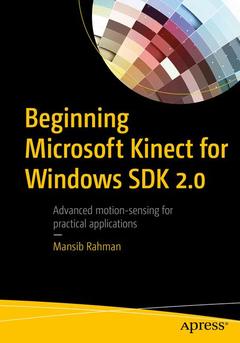Description
Beginning Microsoft Kinect for Windows SDK 2.0, 1st ed.
Motion and Depth Sensing for Natural User Interfaces
Author: Rahman Mansib
Language: English
Subjects for Beginning Microsoft Kinect for Windows SDK 2.0:
Support: Print on demand
Description
/li>Contents
/li>Biography
/li>Comment
/li>
Develop applications in Microsoft Kinect 2 using gesture and speech recognition, scanning of objects in 3D, and body tracking. Create motion-sensing applications for entertainment and practical uses, including for commercial products and industrial applications.
Beginning Microsoft Kinect for Windows SDK 2.0 is dense with code and examples to ensure that you understand how to build Kinect applications that can be used in the real world. Techniques and ideas are presented to facilitate incorporation of the Kinect with other technologies.
- Set up Kinect 2 and a workspace for Kinect application development
- Access audio, color, infrared, and skeletal data streams from Kinect
- Use gesture and speech recognition
- Perform computer vision manipulations on image data streams
- Develop Windows Store apps and Unity3D applications with Kinect 2
- Take advantage of Kinect Fusion (3D object mapping technology) and Kinect Ripple (Kinect projector infotainment system)
Introduction-.1. Getting Started.- 2. Understanding How the Kinect Works.- 3. Working with Image Data Sources.- 4. Audio & Speech.- 5. Body & Face Tracking.- 6. Computer Vision & Image Processing.- 7. Game Development with Unity.- 8. Miscellaneous Tools.- 9. Appendix: Windows 10 & Universal Windows Platform.

